

Supernova remnants—the gaseous remains of high-mass stars that have reached the end of their lives—are often complex, large and colorful. The Veil Nebula checks all of those boxes and more. Found approximately 2,000 light-years from Earth toward the Cygnus constellation, astronomers estimate that the star, which once weighed more than 20 Suns combined, exploded roughly 8,000 years ago… meaning its light first reached Earth 6,000 years back.
Today, the debris field stretches nearly 110 light-years across, and has expanded noticeably in just 18-year’s time—when Hubble’s Wide-Field and Planetary Camera 2 (WFPC2) conducted the first detailed observations of the Veil Nebula. Now, NASA and the ESA have combined the old data with the new (taken by Hubble’s Wide-Field Camera 3).
The colors here have distinct purposes. Blue, for instance, traces the outline of a cavity carved out by the supernova shockwave. Red filaments are representative of hydrogen.
The ESA delves deeper:
The blue colored features—outlining the cavity wall—appear smooth and curved in comparison to the fluffy green and red colored ones. This is because the gas traced by the blue filter has more recently encountered the nebula’s shock wave, thus still maintain the original shape of the shock front. These features also contain hotter gas than the red and green colored ones. The latter excited longer ago and have subsequently diffused into more chaotic structures.
Hidden amongst these bright, chaotic structures lie a few thin, sharply edged, red colored filaments. These faint hydrogen emission features are created through a totally different mechanism than that which generates their fluffy red companions, and they provide scientists with a snapshot of the shock front. The red color arises after gas is swept into the shock wave—which is moving at almost 1.5 million kilometers per hour—and the hydrogen within the gas is excited by particle collisions right at the shock front itself.
Despite utilizing six full Hubble fields of view, these new WFC3 images cover just a tiny fraction of the nebula’s outer limb. Located on the west side of the supernova remnant, this section of the outer shell is in a region known as NGC 6960 or—more colloquially—the Witch’s Broom Nebula.
[Reference: European Space Agency]
The Veil Nebula is associated with Cygnus Loop. (See a larger image here)